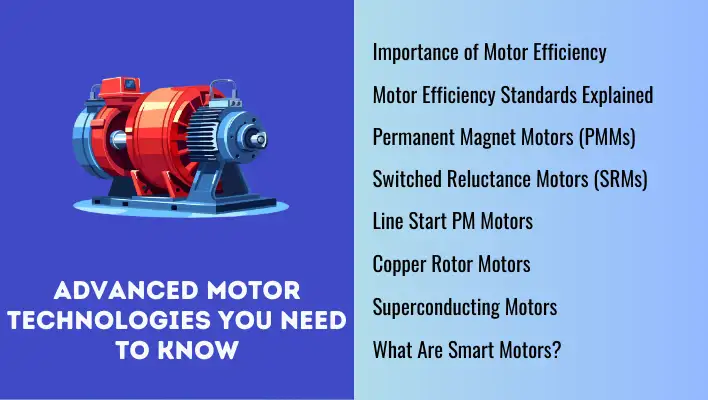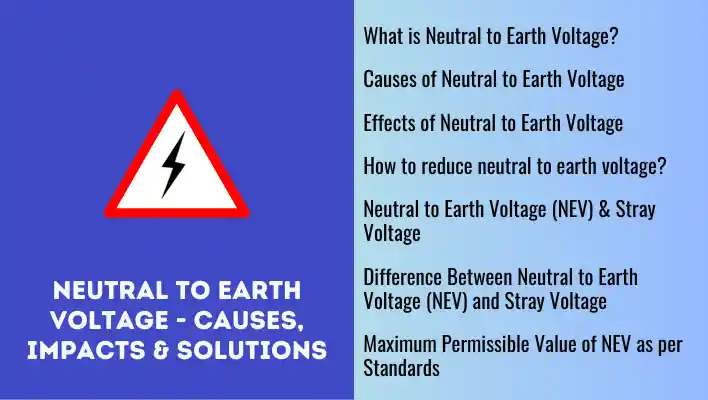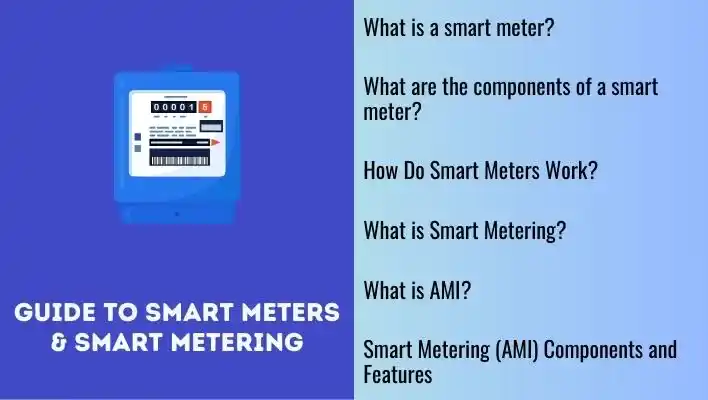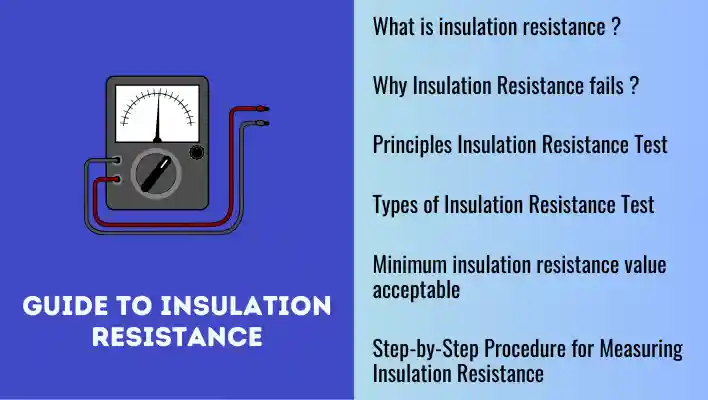Discover the fundamentals of wind energy in this blog post. We’ll explore how wind energy works, the technology of wind turbines, the role of wind farms and the key factors influencing wind energy production. You’ll also get insights into the significant advantages, such as sustainability and clean energy, and the main disadvantages, like intermittent supply, associated with wind energy. Join us as we delve into the essential facts of wind energy.
What is wind? How winds are formed?
Wind is air on the move, and it’s mainly caused by differences in air pressure in the atmosphere. This wind causing motion is called the “pressure gradient force,” and it moves air from high-pressure areas to low-pressure areas.

The stronger this force is, the faster and more powerful the wind becomes. There are three key reasons for this force:
- Sun’s Heat: The Sun heats our planet unevenly, so some places get warmer air while others get cooler air. When warm air rises and cool air sinks, it creates a circular motion of air, which we call convection, and that’s what makes the wind blow.
- Earth’s Spin: The Earth’s spinning affects the wind too. It divides the Earth into different pressure zones, and as it rotates, these zones move around, causing the wind to blow.
- Land-forms: The shape of the land can also influence the wind. Mountains and valleys, for example, can make the wind swirl and change its path when it flows over them.
In simple terms, wind is air moving around because of differences in air pressure, thanks to the pressure gradient force. This force happens because of how the Sun heats the Earth, the Earth’s spin, and the shape of the land.
Also Read: Renewable Energy | A comprehensive explanation
How Does Wind Energy Work?
Wind energy is the power we get from the force of the wind. Wind turbines change the energy from moving air into mechanical power and later into electricity with a generator. This works especially well when strong winds make the turbine blades spin faster.
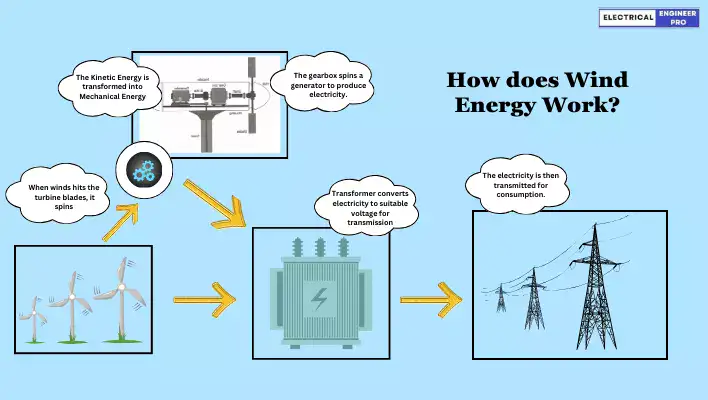
Here’s a more detailed breakdown of how a wind energy works:
- Wind’s force: When the wind hits the turbine blades, it creates lift and acts like an airplane wing, making the blades spin.
- Rotational Motion: The turbine blades are connected to a rotor, so when the blades spin, the rotor turns too.
- Slow Spin: Inside the nacelle, the big housing at the top of the tower, there’s a slow-speed shaft. It turns at a slow pace, about 15-20 times per minute (RPM), which isn’t fast enough for making electricity.
- Gearing Box: To create electricity, the slow-speed shaft gets a boost from a constant-speed gearbox, which significantly raises the rotation speed. The generator thus spins at the same frequency as the electrical grid, typically 1500 RPM for 50 Hz or 1800 RPM for 60 Hz to produce electricity.
- Electricity Generation: The high-speed rotation of the generator produces an electric potential difference, known as voltage or electricity.
- Transformer: This electricity is sent to a transformer that adjusts its voltage to match what the electrical grid needs.
- Electricity Transmission: Once transformed, the electricity is sent through the grid to power our homes, businesses, and industries.
- Nacelle and Yaw Mechanism: The gearbox, generator, and control system are housed within a nacelle located at the top of the tower. This nacelle has a smart system, a yaw mechanism, that points the turbine in the right direction so it captures the most wind, no matter which way it’s coming from.
Good to Know: Difference between Wind and Air. The mixture of gases that makes up Earth's atmosphere is air, while the movement or flow of that air is wind. Various factors, including differences in pressure, temperature, and other meteorological forces, cause wind, setting it apart from the static and constant nature of the air itself. Wind represents the dynamic aspect of air, showcasing its motion from one place to another.
How much wind is needed for a wind turbine to operate efficiently?

The amount of wind needed for a wind turbine to function effectively depends on several factors, including the type of wind turbine, its design and its intended purpose. Here are some key considerations:
- Cut-In Wind Speed: Every wind turbine needs a bit of a push to get going, and that’s called the “cut-in wind speed.” This speed typically ranges from 5 to 10 miles per hour for small residential turbines and can be higher for larger utility-scale turbines.
- Rated Wind Speed: When the wind is at its most efficient speed, it’s called rated wind speed, that’s when a wind turbine performs at its best. It’s typically around 20 to 30 miles per hour. At this point the turbine hits full power mode, generating its maximum electricity.
- Cut-Out Wind Speed: In strong winds turbines spin fast, so it needs to be saved from damage. That’s why there’s a “cut-out wind speed”, which is the maximum wind speed at which the turbine shuts down. When the wind goes too wild at around 55 to 65 miles per hour, the turbine shuts down to stay safe.
- Wind Turbine Type: The required amount of wind may vary depending on the type of wind turbine. Some turbines, such as traditional horizontal-axis turbines, are designed to capture wind from a specific direction. In contrast, others, like vertical-axis turbines, are more flexible and can capture wind from any direction.
- Turbine Size: Size matters too. Bigger rating turbines can harness energy even from lighter winds because they have these massive rotor blades and super-efficient designs.
- Location: The location chosen for erecting wind turbines is also an important aspect. Wind maps and data should guide the selection of a place where the wind is consistent and strong enough to keep the turbine blades spinning.
- Purpose: Some wind turbines are designed for low-wind areas and are optimized for capturing energy in light breezes. Others are meant for high-wind areas and can handle stronger winds.
It’s important to note that while wind turbines can start generating electricity at relatively low wind speeds, they become more productive and efficient as wind speeds increase within their rated range. Proper siting, wind turbine selection, and wind resource assessment are essential to ensure that a wind turbine functions effectively and provides a reliable source of renewable energy.
Good to Know The important point here to be noted is that wind speed largely determines the amount of electricity generated by a turbine. Wind energy increases with the cube power of the wind speed. If you double the wind speed, the energy potential increases by a factor of 8.
Also Read: Explained | Top 7 Solar Energy technologies
What are the various components of wind turbines?
The wind turbines whether they’re large or small are similar in design. A wind turbine consists of three main parts:
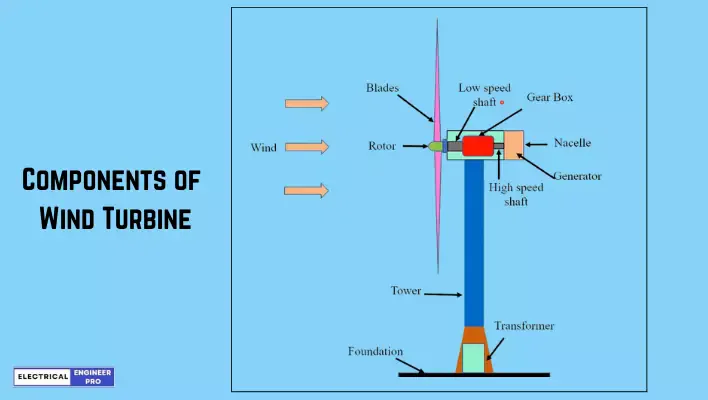
- Rotor System: This is the part of the wind turbine that directly interacts with the wind to capture its energy. It includes:
Blades: These are aerodynamically designed components that resemble large propellers. They capture the kinetic energy of the wind and convert it into rotational motion.
Rotor Hub: The rotor hub is at the center of the blades and connects them to the main shaft of the turbine. It’s essentially the central point around which the blades rotate.
Pitch Mechanism: Wind turbines often have a mechanism to adjust the angle or pitch of the blades. This helps optimize the capture of wind energy by ensuring the blades are positioned correctly in relation to the wind direction.
- Nacelle: The nacelle is like the “heart” of the wind turbine, located on top of the tower. It contains several critical components, including:
Main Shaft: The main shaft connects the rotor hub to the gearbox. It transmits the rotational energy from the rotor to the other components.
Gearbox: The gearbox is responsible for increasing the rotational speed of the rotor to a level suitable for the generator. It acts as a mechanical transmission system.
Generator: The generator is a key component that converts the mechanical energy from the rotating shaft into electrical energy.
Brake: Wind turbines have a braking system to slow down or stop the rotation of the rotor in high winds or during maintenance.
Bearings: Bearings are used to support and facilitate the rotation of the various components within the nacelle.
Nacelle Frame: This is the structural framework that houses and supports the components within the nacelle.
Yaw Mechanism: The yaw mechanism allows the nacelle to rotate and face into the wind, ensuring the blades are always oriented to capture the wind’s energy optimally.
Auxiliary Crane: An auxiliary crane is sometimes included for maintenance and repairs.
Hydraulic System: It controls various functions within the nacelle, including pitch adjustments and brake operation.
Cooling System: To prevent overheating, a cooling system may be present, especially in larger turbines.
- Tower and Foundation: These are the structural elements that provide stability and support to the entire wind turbine. The tower raises the nacelle and rotor high above the ground to capture higher and more consistent wind speeds. The foundation, usually anchored in the ground, supports the tower and transfers the forces and moments created by the turbine to the ground.
What are Wind Farms?
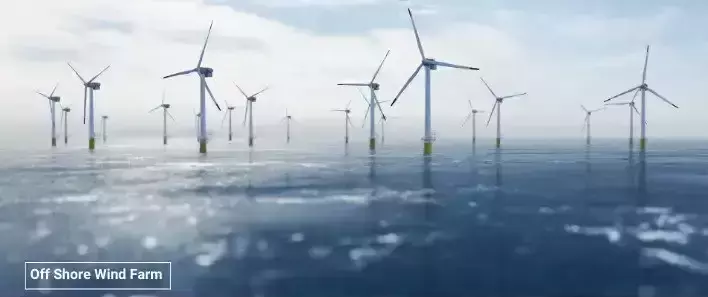
Wind farms are like these huge powerhouses of clean energy. They’re basically a collection of lots and lots of wind turbines all working together to generate electricity. Imagine those gigantic windmills spinning gracefully in the wind; that’s what a wind farm looks like.
Here are some key points about wind farms:
Formation of Wind Farms: Wind farms form when a group of individual wind turbines is strategically placed at the same location with the primary goal of generating electricity. These turbines harness the power of the wind to produce clean, renewable energy.
Interconnection of Turbines: The individual wind turbines within a wind farm connect to one another through a medium voltage power collection system and a communications network. This network enables efficient coordination and control of the turbines, optimizing their performance.
Voltage Transformation: A transformer steps up the electrical current generated by these turbines, initially at medium voltage, into high voltage. This transformation is necessary to make the electricity suitable for transmission over long distances. The high-voltage electricity integrates into the transmission system of the electrical grid, making it available for distribution to homes, businesses, and industries.
Scale and Scope: Wind farms can vary significantly in terms of their size and scope. Some wind farms may consist of just a few dozen individual wind turbines, while larger ones can encompass several hundred turbines. These farms often cover an extended area, spanning hundreds of square miles, to capture the full potential of wind resources.
Offshore Wind Farms: In addition to onshore wind farms, there is another exciting category known as offshore wind farms. These farms are positioned in bodies of water, such as oceans or lakes, to take advantage of the strong, consistent winds that blow over these surfaces. Offshore wind farms are gaining popularity due to their potential for capturing vast amounts of wind energy, though they come with unique engineering and environmental considerations.
What are the advantages of Wind Energy?
- Clean – in wind energy there is no combustion process. Hence there are zero greenhouse gas emissions which cause global warming.
- No waste – There are no waste products produced during generation of energy via wind so nothing is there to be disposed of or scrapped.
- No water required – No water is required to either cool the machines or to remove the effluent within the machines.
- Renewable – The wind is an unlimited resource and will blow as long as the sun shines. As an alternative to burning fossil fuels, wind power is abundant, widely distributed, clean, generates no greenhouse gas emissions during operation and requires no water consumption.
- Cheap – Once installed, wind turbines maintain a low operating cost since wind is a free resource. The most important factor contributing to this cost-effectiveness is that electricity generated from wind farms is sold at fixed prices, independent of external factors, unlike power generation plants relying on fossil fuels.
- Low Impact – Wind farms are constructed following an extensive analysis and planning procedure. Depopulated locations are also explored to avoid detrimental effects on residents.
- Availability in Isolated Areas – The one-time investment can benefit isolated areas by supplying electricity. In regions with inadequate conventional power distribution, wind power can serve as a savior. Modern technology enables the efficient utilization of free wind energy.
- Generates Green Jobs – According to the International Renewable Energy Agency (IRENA), wind energy currently employs over 1.2 million people, and the number of green jobs will continue to grow.
Main Disadvantages of Wind Energy
An inherent weakness of all wind machines is their strong dependency on wind speed. The main disadvantages of wind energy are as,
- The wind speed is not constant and can go from zero to high at any time.
- The capacity factor (availability or utilization) is low due to fluctuating electricity production. Both weak and strong winds can cause a turbine shutdown, resulting in no electricity production at all.
- Depending on their location, turbines can produce noise.
- Wind turbines have been observed to cause harm to wildlife, particularly birds and bats.
- Wind turbines come with a high initial cost, though they recoup their expenses relatively quickly.
- Large space is needed for installation of wind turbines.
What Are the Major Applications of Wind Energy?
Let’s talk about the major applications of wind energy, and why they matter.
Land-Based Wind Energy: Most wind turbines are placed on land and for good reason. These giants spin to generate electricity that powers our homes, businesses and more. Land-based wind energy isn’t just reliable; it’s also one of the most cost-effective ways to generate electricity. In fact, the U.S. Department of Energy has published data showing that it’s among the lowest-cost sources of power.
Distributed Wind Energy – Powering Communities: This type of wind energy is small scale but makes a big impact. Distributed wind energy can range from tiny turbines to larger ones, often used to power individual buildings or small communities. They’re the local heroes, reducing energy bills, pumping water and lowering air pollution. These turbines are becoming better and more efficient, making them even more accessible for homeowners, farmers and businesses.
Offshore Wind Energy – Harnessing the Sea Breeze: Imagine colossal turbines out in the ocean, harnessing the powerful sea breeze. They can provide electricity for everything from marine research to entire cities on the coast. The industry is growing, and the U.S. Department of Energy predicts significant potential for offshore wind energy along the coastlines.
FAQs
What are some innovations in wind energy?
Recent innovations in wind energy include the deployment of floating turbines in deep offshore waters, the integration of smart technology for optimized performance using data analytics, advancements in rotor blade design with lighter materials and adaptive features, the exploration of compact vertical axis turbines suitable for urban areas, pairing wind turbines with energy storage solutions for enhanced reliability.
How is wind power renewable?
Wind energy is generated by harnessing the power of wind through wind turbines. These turbines convert the kinetic energy of the wind into electricity. It’s renewable because it’s a inexhaustible and clean resource, producing no greenhouse gas emissions..
Are there any challenges associated with wind energy implementation?
Challenges may include intermittent wind patterns, potential impact on wildlife, and initial investment costs. However, advancements in technology and careful planning can address these challenges effectively.
Can wind energy be used for residential purposes?
Yes, small-scale wind turbines are available for residential use. They can supplement or replace traditional energy sources, providing clean and locally generated power.
What is the lifecycle of a wind turbine, and how is it environmentally friendly?
Wind turbines have a relatively low environmental impact throughout their lifecycle. The energy generated during operation offsets the environmental costs associated with manufacturing, installation, and decommissioning.



